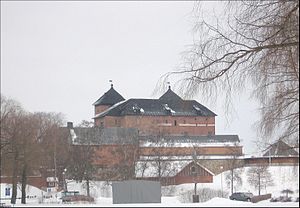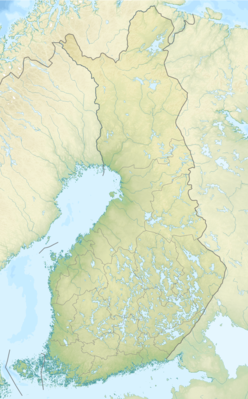Häme Castle
| Häme Castle | ||
|---|---|---|
|
Häme Castle in winter |
||
| Alternative name (s): |
Hämeen linna ( Finnish ), Tavastehus slott ( Swedish ) |
|
| Creation time : | around 1260 | |
| Castle type : | Niederungsburg, location | |
| Conservation status: | Receive | |
| Standing position : | Reichsburg | |
| Construction: | Brick | |
| Place: | Hämeenlinna | |
| Geographical location | 61 ° 0 '12 " N , 24 ° 27' 34.9" E | |
|
|
||
The Häme Castle is a castle in Hämeenlinna (Swedish Tavastehus), Finland . It is one of the few examples of medieval brick Gothic in Finland.
location
The castle stands on the coast of Lake Vanajavesi in the city center on a steep moraine hill . The castle originally stood on an island. It is surrounded by a spacious green area.
history
In the first half of the 13th century , the Swedes under Birger Jarl undertook several crusades to Finland. To secure the results of this crusade, the castle of Häme was built. The first written mention of the castle dates from 1308.
Probably the castle, together with the 10 km away was Castle Hakoinen and the castle Vyborg ( Vyborg ) and the Turku Castle part of a large building program, with which the Folkunger wanted to strengthen the Swedish rule over Finland.

Häme Castle developed from a simple fort (approx. 1260) via a field stone castle (approx . 1270) to a brick castle (approx . 1300–1450). The corner towers were built around 1480–1520. Häme Castle was the seat of the administration of the Häme region .
During the reign of Gustav I. Wasa , the castle was modernized and turned into an artillery fortress. In 1634 the administration was moved to Helsinki . With that the castle lost its importance. During a visit to the castle in 1639, Per Brahe ordered the establishment of the town of Hämeenlinna, north of the castle.
During the Northern War the castle was handed over to the advancing Russian troops in 1711 without a fight . After the war, the castle was converted into the army's central granary in the 1720s and the state bakery was built next to the castle. During the Russo-Swedish War , the castle was taken over by Russian troops on March 8, 1808 without a fight. The Russian troops began to build the castle back into a defense system. With the peace treaty, the castle fell back to Sweden, which continued the construction work that had started.
In 1837 a prison was established in the castle . The castle was rebuilt for this purpose, and the surroundings of the castle were also significantly changed. The defensive walls from the 18th century were leveled. In 1871 the new central prison building was built next to the castle. The prison existed until 1953.
description
The castle administration's account books have been preserved since 1539. Statements about the earlier state of construction are based on archaeological investigations.
Castle (around 1260)
The original fort consisted of a square ring wall and three corner towers. The side length was 33 m, the height 7 m. The fort had a well.
Feldsteinburg (around 1270)
After Hakoinen Castle was given up in favor of Häme Castle, the fort was expanded to become a castle. Stone buildings were erected between the existing corner towers. An inner courtyard was created with dimensions of 13 to 14 m. The rooms of this building era still form the core of the castle.
Brick castle (from 1300)
In order to improve the defense of the castle, the cock tower was built from 1300. This also served as a residential tower. It was the first building element made of brick . Bricks were also used to add to the castle. There are clear structural similarities with castles in Mecklenburg . These are mainly present in ornamentation .
The last medieval construction phase began in 1480. The reason was the collapse of the north corner. The foundations of the Feldsteinburg could no longer withstand the load. In addition to the reconstruction of the north corner, the north-west wing was also redesigned and the other corner towers reinforced and raised.
From 1539 to 1570 the castle was expanded on the instructions of Gustav I. Wasa. Cannon towers were erected, and the outer defenses and farm buildings were repaired. In 1599 a powder explosion destroys the south tower, the subsequent fire destroys all wooden structures in the castle. The castle was rebuilt between 1606 and 1611.
On June 5, 1659, another fire damaged the castle. However, the castle was immediately renovated.
After this expansion phase, the curtain wall had reached a height of 8 m and a thickness of 1.5 m.
Todays use
From 1956 the castle was renovated. The aim was to highlight the medieval castle again. In 1979 the castle became a museum. The Hämeenlinna Historical Museum is located in the central prison building.
Varia
In 2014, in a series of stamps by the Finnish Post with images of old Finnish castles, Häme Castle was reversed due to an error.
literature
- Elias Härö, Vilma Vaikonpää: The Hämeenlinna Castle . National Office of Antiques, Finland, Helsinki 1982, ISBN 951-9074-71-6
See also
Web links
- Häme-Burg (English)
- Hämeenlinna Castle on Burgenwelt.org (German)
Individual evidence
- ↑ http://193.184.161.234/DF/detail.php?id=252 ( Memento from September 27, 2007 in the Internet Archive ) (Latin.) (Accessed May 31, 2014)
- ↑ Finnish Castles on stamps - one backwards ( en ) May 26, 2019. Accessed May 31, 2014. ( Page no longer available , search in web archives )



